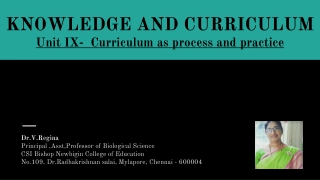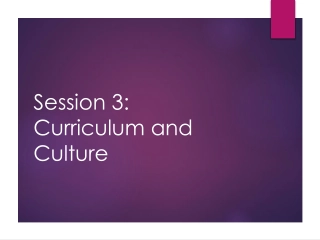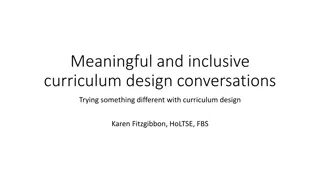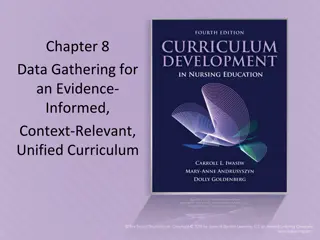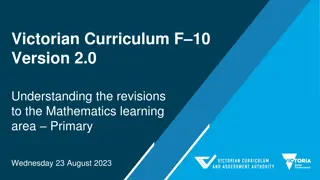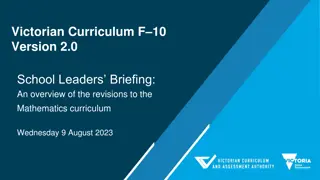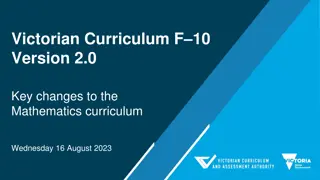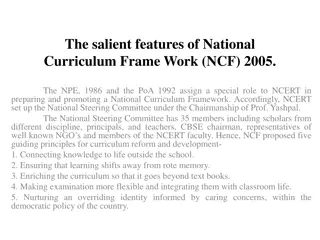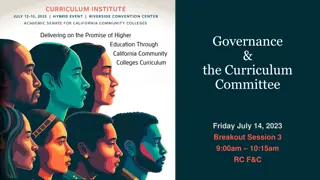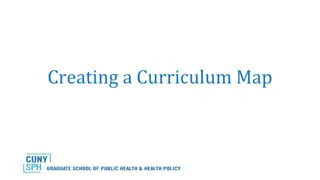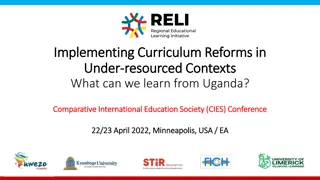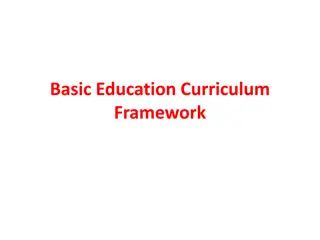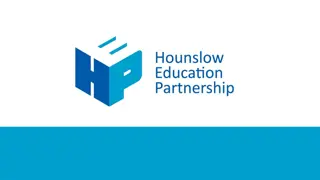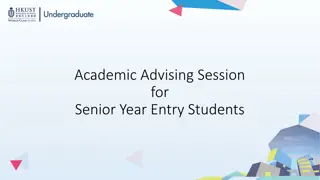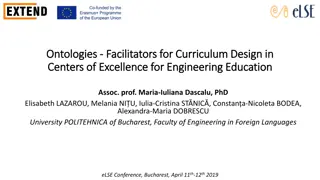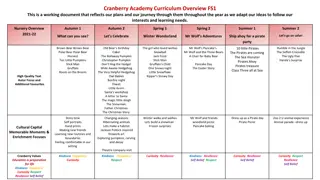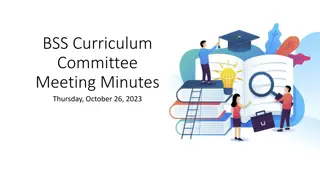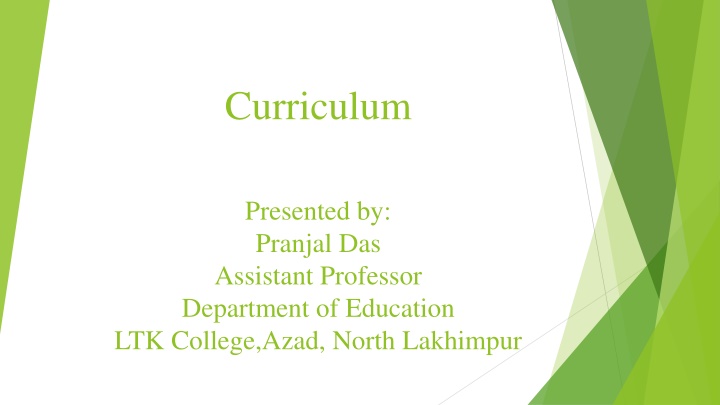
Curriculum Development and Syllabus: Key Concepts and Principles
Explore the concepts of curriculum development and syllabus, including their characteristics, differences, and principles. Understand how they shape educational systems and courses, focusing on student-centered approaches and community needs. Gain insights into the importance of experience, creativity, and flexibility in designing effective curricula.
Download Presentation

Please find below an Image/Link to download the presentation.
The content on the website is provided AS IS for your information and personal use only. It may not be sold, licensed, or shared on other websites without obtaining consent from the author. If you encounter any issues during the download, it is possible that the publisher has removed the file from their server.
You are allowed to download the files provided on this website for personal or commercial use, subject to the condition that they are used lawfully. All files are the property of their respective owners.
The content on the website is provided AS IS for your information and personal use only. It may not be sold, licensed, or shared on other websites without obtaining consent from the author.
E N D
Presentation Transcript
Curriculum Presented by: Pranjal Das Assistant Professor Department of Education LTK College,Azad, North Lakhimpur
Curriculum The term curriculum is derived from the Latin word currere which means rub and it signifies a runway or a course which one runs to reach a goal . The term curriculum refers to the lessons and academic content taught in a school or in a specific course or program. According to Cunningham, curriculum is a tool in the hands of the artist(teacher),to mould his material (pupil),according to his ideal (aims and objectives) in his studio(school)
Characteristics of Curriculum Dynamic Development of personality Totality of experience The Curriculum is based on the needs of the people The Curriculum provides for the logical sequence of subject matter The Curriculum is democratically conceived. The Curriculum provides for the logical sequence of subject matter
Syllabus Syllabus basically means the subjects as well as the topics which are there in a particular course. The syllabus determines the basic content of instructions in a given subject and the range of knowledge and skills which the pupils must acquire and establish in detail, the themes and individual points to be studied in each school year.
Difference between Curriculum and Syllabus Basis Meaning Syllabus Syllabus is the document that contains all the portion of the concepts covered in a subject. Greek term A subject Descriptive Narrow Set out by Exam board curriculum Curriculum is the overall content, taught in an educational system or a course Latin term A course Prescriptive Wide Government or the administration of school, college or institute Till the course lasts Origin Set for Nature Scope Term For a fixed term, normally a year
Principles of Curriculum development Principle of Child-centeredness Principle of Community-Centeredness. Principle of Experience. Principle of Integration Principle of Creativity. Principle of Elasticity and Variety. Principle of Diversification. Principle of Common Subjects. Principle of Earning of Livelihood. People of utilization of leisure.
Factors affecting Curriculum Social factors Religious factors Geographical factors Economic factors Ideological factors Policies
Approaches of Curriculum Development Subject-Centered Approach: This approach is based on the classification and organization of subject-matter into discrete groups which we called subjects. Broad-Field Approach: In this approach we try to organize the curriculum in such a way that it involves two or more subject areas under a broad field. E.g. Social studies- history, geography, economics, sociology, politics etc. Approach: This organizing that type of curriculum which revolve around major problems of issues in the society. E.g. Secularism, Communalism, Casteism, Terrorism etc. Social-Problem approach gives emphasis on Learner-Centered Approach: Learner-centred approach emphasizes on individual development, cares about students needs, interests and purposes, plans teaching according to the interest of students.
Emerging Trends in Curriculum Development Language education Value education Computer education
Models of Curriculum Development I. Ralph Tyler Model: One of the best known curriculum models is The Tyler Model introduced in 1949 by Ralph Tyler in his classic book Basic Principles of Curriculum and Instruction. There are Four Basic Principles Tyler model 1. What educational purposes should the school seek to attain? 2. What educational experiences can be provided that are likely to attain these purposes? 3. How can these educational experiences be effectively organized? 4. How can we determine whether these purposes are being attained or not?
Contd. II. Hilda Taba Model: Another approach to curriculum development was proposed by Hilda Taba in her book Curriculum Development: Theory and Practice published in 1962.She argued that there was a definite order in creating a curriculum. She believed that teachers, who teach the curriculum, should participate in developing it which led to the model being called the grass-roots approach. She noted 7 major steps to her grass-roots model in which teachers would have major input. These are- i. Diagnosis of need: The teacher who is also the curriculum designer starts the process by identifying the needs of students for whom the curriculum is planned. For example, the majority of students are unable to think critically. ii. Formulation of objectives: After the teacher has identified needs that require attention, he or she specifies objectives to be accomplished. iii. Selection of content: The objectives selected or created suggest the subject matter or content of the curriculum. Not only should objectives and content match, but also the validity and significance of the content chosen needs to be determined. i.e. the relevancy and significance of content
Contd. iv. Organization of content: A teacher cannot just select content, but must organize it in some type of sequence, taking into consideration the maturity of learners, their academic achievement, and their interests. v. Selection of learning experiences: Content must be presented to students and students must be engaged with the content. At this point, the teacher selects instructional methods that will involve the students with the content vi. Organization of learning activities: Just as content must be sequenced and organized, so must the learning activities. Often, the sequence of the learning activities is determined by the content. But the teacher needs to keep in mind the particular students whom he or she will be teaching vii. Evaluation and means of evaluation: The curriculum planner must determine just what objectives have been accomplished. Evaluation procedures need to be designed to evaluate learning outcomes
Contd. III. CIPP Model-This model was created by Daniel L. Stufflebeam, a professor at Western Michigan University.And it stands for- C-context I-input P-process P-product The CIPP evaluation model is designed to systematically guide both evaluators and stakeholders in posing relevant questions and conducting assessments at the beginning of a project, while it is in progress, and at its end. This approach seeks to improve and achieve accountability in educational programming through a learning-by-doing approach (Zhang et al., 2011).
Contd. Key components of the CIPP model and its need- A. Context evaluation: Assess overall environmental readiness of the project; 2. Examine whether existing goals and priorities are attuned to the needs; 3. Refers to as needs assessment; 4. The expanded focus is to identify the strengths and weaknesses of an institution, program to indicate direction for improvement. B. Input Evaluation: 1. Refers to the ingredients of the curriculum which include the goals, instructional strategies, the learners, the teachers, the contents and all the materials needed; 2. This includes the steps and resources needed to meet the new goals and objectives and may also include successful external programs and materials as well as gathering information
Contd. C. Process Evaluation: 1. Refers to the ways and means of how the program has been implemented; 2. Monitors the program/project implementation process; 3. Assess to which participants accept and carry out their roles; 4. The focus is the implementation of a program or a strategy; 5. The main purpose is to provide feedback about needed modifications if the implementation is inadequate. D. Product Evaluation: 1. Indicates if the program accomplishes its goals; 2. Measure, interpret, and judge a program s outcomes by assessing their merit, worth, and significance; 3.Ascertain the extent to which the needs of all the participants were met; 4. Should document both intended and unintended effects/ positive as well as negative outcomes; 5. Determine whether a program should be continued, repeated, and/or extended.
Contd. IV. Goal-free Model- In the goal-free evaluation model developed by Michael Scriven (1972), the evaluation looks at a program's actual effect on identified needs. Goal-free any evaluation in which the evaluator conducts the evaluation without particular knowledge of or reference to stated or predetermined goals and objectives. Major characteristics of the model: model is a kind of evaluation is Evaluator actively avoids information regarding program goals. Evaluator does not have preconceived goals in order to narrow the focus. Evaluator has minimal contact with staff or members of the program. Without information regarding goals, evaluator is more likely to see unanticipated effects of program. Use of goal free model: Information about program outcomes, both intended and unintended When evaluators wants to unintentionally have no knowledge of program goals, intentionally or Want to identify the effect of a program from data collection, observations, and interviews.
Stages of Curriculum Development Curriculum Planning Curriculum Designing Curriculum Implementation Curriculum Evaluation
Curriculum Planning Is the process of structuring academic experiences, using expertise knowledge of the teacher. It is the activity which teachers get involved in before the actual implementation. It is a continuous process which involves activities characterized individuals and Groups as they work together in studying, planning, developing and improving the curriculum, which is the total environment planned by the school. by interrelationships among Some of the factors upon which the curriculum planning is based on: 1. Socials forces. 2. Nature of learning 3. Time schedule 4. Institutional resources 5. Knowledge of human development
Steps involved in Curriculum planning Need analysis : Needs analysis has a vital role in the process of designing curriculum and considered as a crucial component of systematic curriculum development. It helps to identify the needs of students and teachers as well as the possibilities of development. Needs analysis can helps teachers understand local needs of students or the needs of a particular group of students and make practical decision in pedagogy and assessment for improvement, and also for the selection of appropriate teaching methods in a program. Needs analysis may provide the basis for planning goals and objectives for a future program, and also for developing syllabus design and teaching materials for the course. curriculum planning develops a program that attempts to meet students perceived needs will be more motivating and successful. Curriculum development should be viewed as a process by which meeting student needs leads to improvement of student learning.
Contd. Committee formation: The main function of the curriculum committee is that of primary responsibility for the development, review, renewal, and recommendation of curriculum to be approved by the Board of Trustees. Effective curriculum renewal and development require a effective curriculum committee to ensure the highest possible quality for the curriculum offerings that can be made available within allocated resources. Effective leadership must be forthcoming from faculty, and administration must provide adequate resources and support so that effective, quality curriculum can be attained in a cost effective manner. From all of these cooperative efforts should emerge a dynamic curriculum development and renewal process that produces the desired quality, effective curriculum. In addition, the process should be highly adaptive to needed changes and, at the same time, insulates quality, effective curriculum already in place from transitory, faddish, or disruptive pressures.
Contd. Assessment of issues: Assessments is need for any number of purposes, from conducting large-scale evaluations of multiple components of educational programs to measuring individual students mastery of a specified skill. Effective assessment should reveal whether students truly understand those principles and can apply their knowledge in new situations. A important step in any curriculum development process involves research that reviews recent issues and trends of the discipline, both within the district and across the nation. This research allows a curriculum committee to identify key issues and trends that will support the needs assessment that should be conducted and the philosophy that should be developed. It enable individual to demonstrate attainment in a range of different subject areas Setting the level of the learner: curriculum should be prepared according to the developmental level of the learners.
Contd. Duration of the course: Although courses may vary in size, subject matter or level, a systematic process will help you plan and structure your course and syllabus to effectively reach desired instructional goals. Effective course design begins with understanding who your students are, deciding what you want them to learn; determining how you will measure student learning; and planning activities, assignments and materials that support student learning.
Contd. Setting of goals and objective: This step provide direction or intent to educational action. Broad education goals communicate the overall purposes of a curriculum and serve as criteria against which the selection of various curricular components can be judged. The development of specific measurable objectives permit further refinement of the curricular content and guide the selection of appropriate educational and evaluation methods. Clearly communicate performance expectations of residents to learners, faculty, nurses and other staff Help direct the choice of curricular content and the assignment of relative priorities to various components of the curriculum Suggest what learning methods will be most effective and Suggest what evaluation methods are appropriate Enable evaluation of learners and the curriculum, thus permitting demonstration of the effectiveness of a curriculum
Curriculum Design The process of defining and organizing the components of curriculum into a logical pattern is known as curriculum design. It refers to the structure or the arrangement of the components or elements of a curriculum Approaches to Curriculum Design: The common approaches to curriculum design includes Child or Learner-Centered Approach-this approach to curriculum design is based on the underlying philosophy that the child is the center of the educational process. It means that the curriculum is constructed based on the needs, interest, purposes and abilities of the learners. The learners are empowered to shape their own learning from the different opportunities given by the teacher.
Contd. Subject-CenteredApproach: the primary focus is the subject matter. A curriculum can also be organized around a subject center by focusing on certain processes, strategies, or life-skills, such as problem solving, decision making, or teamwork Problem-centered Approach: this approach is based on a curriculum design which assumes that in the process of living, children experience problems. Thus, problem solving enables the learners to become increasingly able to achieve complete or total development as individuals.
Principles of Curriculum Design 1.scope Tyler referred to scope as consisting of all the content, topics, learning experiences and organizing threads comprising the educational plan. It does not only refers to the cognitive content but also affective and psychomotor. Broad, limited, simple, general are the words used to describe the scope. Decision making of the teacher is needed. By scope we mean all the varieties and types of experiences that are to be provided to the students through educational
Contd. 2. Sequence: Aparticular order in which related events, movements, or things follow each other Contents and experiences are arranged in hierarchical manner 4 principles of sequence- Simple to complex learning content & experiences are organized from simple to complex, concrete to abstract, easy to difficult Prerequisite Learning- there are fundamental things to be learned ahead. Whole to Part Learning overview before the specific content or topics. Related to gestalt principle. Chronological learning the order of events is made as a basis of sequencing the content and experiences. 3. Continuity - vertical repetition and recurring appearances of the content provide continuity in the curriculum. This process enables the learner to strengthen the permanency of learning and development of skills. Bruner calls this spiral curriculum . For learners to develop the ideas, these have to be developed and redeveloped in a spiral fashion in increasing depth and breath as the learners advance
Contd. 4. Integration: Everything is integrated and interconnected. This is the essence of integration in the curriculum design It refers to the linking of all types of knowledge and experiences. It allows the learner to obtain a unified view of knowledge and in-depth meaning of the subject matter. 5.Articulation: It refers to the inter relatedness of various aspects of curriculum. This can be either vertical or horizontal. In vertical articulation, contents are arranged from level to level or grade to grade so that the content in a lower level is connected to the next level. Horizontal articulation: it refers to the association between or among elements occurring simultaneously. For instance, when curriculum designer attempt to develop interrelationship between 8thstandard social studies and 8thstandard science course.
Contd. 6. Balance: It means giving appropriate weight to each aspect if the design so that distortions do not occur. Equitable assignment of content, time, experiences and other elements to establish balance is needed in curriculum design Too much or too little of these elements maybe disastrous to the curriculum. Keeping the curriculum in balance requires continuous fine tuning and review for its effectiveness and relevance
Attributes of Curriculum Design Curriculum design is purposeful Curriculum design is deliberate Curriculum design is creative
Criteria for selecting the Curriculum Design Goals and purposes need to be achieved Characteristics of learners need to be identified Nature of knowledge to be provided Type of society for which design is meant.
Curriculum Implementation Curriculum implementation is a that type of process where we try to apply appropriate methods in order to achieve the pre-determined objectives. Here we try to implement the curriculum.
Role of the Teacher in Curriculum Implementation Advise the teachers as well as other learners. Facilitate the teachers as well as learners Develop the curriculum Implement the curriculum
Role of the Students in Curriculum Implementation Give feedback to the teachers. Lead the group in group discussion and help others Follow the instruction of teachers
Role of Administrators and Supervisors in Curriculum Implementation Make necessary rules for curriculum implementation. Guide the teachers if they face any problem. Take necessary decisions according to the need of the situation Give all the facilities to implement the curriculum
Role of Community members in Curriculum Implementation Give feedback to the school about the curriculum Give suggestions for solving any problem.
Role of the Policy Makers and Board of Education in Curriculum Implementation They frame the policies or make rules for implementing the curriculum. They give fund. Set the goals To articulate the values of present curriculum. To inquire about the proposed new curriculum content.
Resources for Curriculum Implementation Textbooks and workbooks Audiotapes Videotapes and videodisc Computer Library resources Laboratory resources
Curriculum Evaluation Curriculum evaluation is a continuous process for collecting information about all the elements and outcomes of the curriculum understanding of the extent to which they have been achieved and subsequently take decisions to improve their efficacy. to help arrive at an
Approaches of Curriculum Evaluation Scientific approach: In this approach behaviourally oriented people tend to look at evaluation as a connection between what is and what all agree ought to be. The ideal of this approach is a pretest-posttest, experimental-control group design. Humanistic approach: It looks at the evaluation in terms of different values of all program participants and in terms of the perceived value of the processes and activities of the programme. Data gathered is more qualitative than quantitative- descriptions of events rather than judgement of event.
Contd. Intrinsic and Pay-Off Evaluation: Intrinsic evaluation focuses on the curriculum design and development with respect to worth of goals and objectives, appropriateness of content and types of learning activities. Pay-Off evaluation focuses on the usually short-term effects of the curriculum. It evaluates the extent to which the objectives were achieved and effects on parents, teachers and administrators. It advocates goal free evaluation in which evaluators looks at all the results of the curriculum (unexpected side effects, overlooked achievement, new priorities), instead of looking only at those effects that were anticipated (such as higher test scores).
Contd. Formative and Summative Evaluation: Formative evaluation takes place at specified points during the development and pilot testing phases of curriculum building in order to identify and correct problems before the curriculum is put into full operation. Summative evaluation focuses on overall effectiveness. It may take place at designated end points throughout the curricular design such as at the end of pilot testing stage and the end of the implementation stage.
Evaluating Elements of Curriculum Objectives Content Method of teaching Evaluation techniques Evaluating students Evaluating teachers
Focus of Curriculum Evaluation First, it attempts to measure whether the learners are achieving the content objectives set forth for in the curriculum. Second, whether the curriculum is doing what is supposed to do.
Why we are doing curriculum evaluation Cronbach (1963) talked about 3 types of decisions for which evaluation is used- A. Course Improvement: deciding what instructional material and methods are satisfactory and where changes are needed. B. Decisions about individuals: Identify the needs of the pupil for the sale of planning of instruction and grouping, acquainting the pupil with his own deficiencies. C. Administrative regulations: Judging how good the school system is, how good individual teachers are. The goal of evaluation must be to answer questions of selection, adoption, support and worth of educational materials and activities. It also serves the need of the policy makers, administrators, and other members of the society for the information about the educational system.
Techniques of Curriculum Evaluation Bharvad, A.J. (2010) talked about the following techniques of curriculum evaluation- Observation Questionnaire Interview Checklist Workshops & Group Discussion
Conclusion We need to contnually re-evaluate curriculum to remove irrelevant knowledge and make room for emerging knowledge - Patrick Miller Opmillerscdsb
References Bharvad, A.J. (2010). Curriculum evaluation. International Research Journal, 1(12), 72-74. Arulsamy, S. (2014). Curriculum development. Neelkamal Publishers: Hyderabad. Retrieved stakeholders-in-curriculum-implementation-16151513 from- https://www.slideshare.net/laralundang/the-roles-of- Retrieved from- http://keydifferences.com/difference-between-syllabus-and- curriculum.html Retrieved https://www.google.co.in/search?q=curriculum+development+quotations&tbm =isch&source=iu&pf=m&ictx=1&fir=xhTrHUTatA3c3M%253A%252CjR9Z0 Fz1lkAfeM%252C_&usg=__Q3DjBbIPcL3BvWsUr9Md5Jbkh9M%3D&sa= X&ved=0ahUKEwifuqfMiYfXAhVEtY8KHRRVAbIQ9QEIOjAD#imgrc=0- X_1CnzEwgXyM: from-

